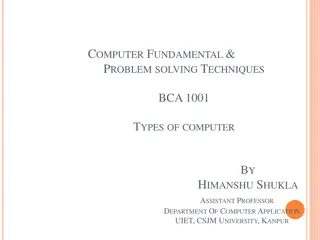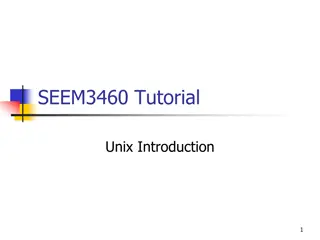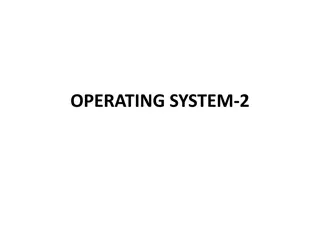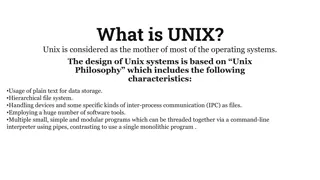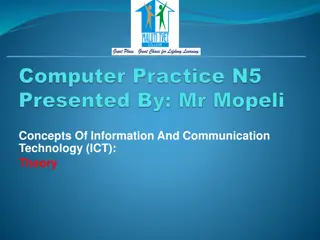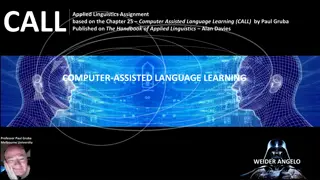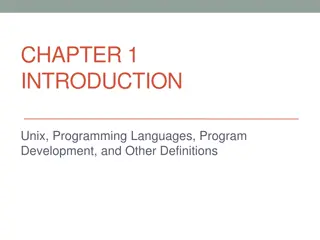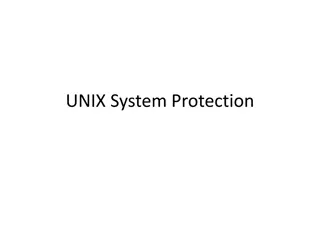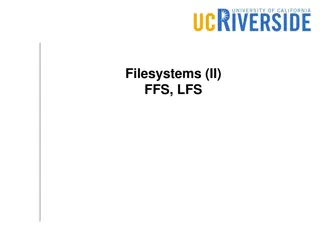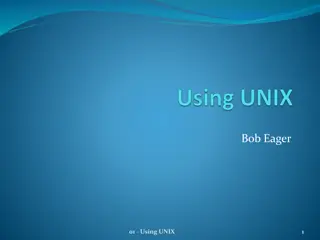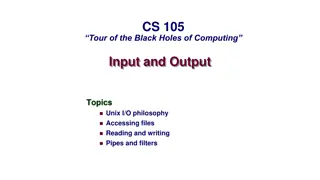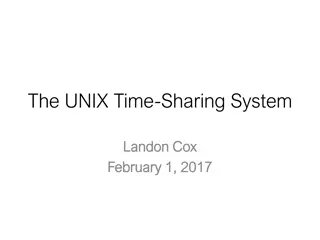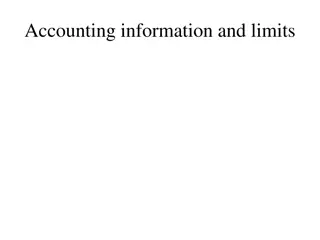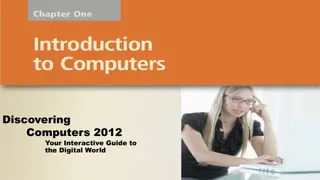Evolution of Operating Systems: From Mainframe Computers to Unix
Before the 1950s, users interacted directly with mainframe computers without an operating system, debugging using control panels. The transition to writing programs in symbolic languages led to the need for specific drivers. Run queues and operator-assisted job submissions marked this era. The first operating system, GM-NAA I/O developed by General Motors for IBM 704, introduced common IO device access routines for batch processing. Subsequently, in the 1960s, major OSes like IBM OS/360, Univac Exec I/II, and Burroughs MCP emerged. The 1970s saw the birth of Unix at Bell Labs, pioneering time-sharing and multi-user capabilities, initially in assembly and later in C.
Download Presentation

Please find below an Image/Link to download the presentation.
The content on the website is provided AS IS for your information and personal use only. It may not be sold, licensed, or shared on other websites without obtaining consent from the author. Download presentation by click this link. If you encounter any issues during the download, it is possible that the publisher has removed the file from their server.
E N D
Presentation Transcript
Before OSes 1950.. Earliest computers were mainframe comp. without an OS. Each user would solely use the comp. for a period of time and the comp. would run the program until completion or crash; debug using a control panel, switches and panel lights. 1) Users first wrote programs in machine code (on punched cards or tape) 2) When symbolic languages, assembler and compilers were available, users wrote programs in programming languages like Fortran; but had to add drivers for the specific architecture, for punch cards/tape reading/writing devices 3) Libraries containing IO drivers became available, so the program would be linked to these libraries
Before OSes 1950.. 4) Run queues with people waiting at the door in order to run a job on the computer 5) Later, an operator would send job to the computer, users would hand the program on punched cards to this operator 6) Run time of a program shortened (due to increase performance on the mainframe), so the delay caused by switching jobs became to high => run-time libraries, i.e. monitors were created that would clear the state of previous job, prepare and execute the next job, save the results, clear the state, take next job 7) These monitors eventually turned into Oses.
First OS - GM-NAA I/O, 1956 First OSes were developed by clients, not the manufacturers GM-NAA I/O was developed by General Motors for their IBM 704 computer Was formed from shared routines that provided common access to IO devices; batch processing Run on 40 computers
First Oses 1950-1960 IBM OS/360, 1960s Control Data Corporation developed Scope and MACE in 1960s or batch processing Univac developed Exec I OS for their Univac 1107 in 1962; they followed with Exec II Burroughs Corporation introduced the B5000 in 1961 with the MCP (Master Control Program) operating system - first OS written in a high-level program. lang., ESPOL General Electric introduced General Electric Comprehensive Operating Supervisor (GECOS) operating system in 1962
Unix Development started in 1969 at Bell Labs by a team lead by Dennis Ritchie, Brian Kernighan and Ken Thompson Name comes from Uniplexed Information and Computing Service Developed on a PDP-11, based on Multics First version (completed in 1971) was implemented entirely in assembly, but version 4 (1973) a large part was written in C Is time-sharing, multi-user and multi-process (14 processes)
Unix Design is modular, has a kernel and a shell containing commands; kernel is monolithical Has an hierarchical file system unifying all components Has IPC (semaphores), pipes Introduced regular expressions Free licensee and portability (impl. In C) added to its success Lines of successors: AT&T (Unix Sys I/II/III/V), University of California, Berkeley (BSD), Microsoft (Xenix), IBM (AIX), and Sun Microsystems (Solaris)
PDP-11, the computer on which Unix was developed
Unix successors Original Unix (Bell labs) 1stedition, 1971 4thedition, 1973 (rewritten in C) 6thedition, 1975 (available outside Bell Labs) 7thedition, 1979 (had Bourne shell) AT&T UNIX System Group (USG) family: Unix System III, 1982 (first public release outside Bell labs) Unix System V, 1983 Unix System V release 2, 1984 (100K instalations) Unix System V release 3, 1987 (750K instalations) Unix System V release 4, 1989 (1.2M instalations) Unix System V release 5, 1998
Unix successors (cont.) The Berkeley Software Distribution (BSD) family: BSD 1, 1978 BSD 2, 1979 BSD 3, 1980 BSD 4.1, 1981 BSD 4.3, 1986 BSD 4.3 Tahoe, 1988 BSD 4.3 Reno, 1990 BSD 4.4, 1993 FreeBSD 1.0, 1993 BSD 4.4-Lite, 1993 NetBSD 0.8, 1992 OpenBSD 1.0, 1995 DragonFly BSD, 2005
Unix successors (cont.) Sun Microsystem family: SunOS 1 (1982), SunOS 4 (1989), Solaris (1991) Solaris 11 (2016) IBM AIX family: AIX 1 (1986) Microsoft & SCO Unix Xenix family: 1980 1989 HP s HP-UX family: 1986 today Apple family: NextSTEP (1989-1995), MacOS, iOS Minix, 1987-2017, Andrew Tanenbaum Linux, 1991 Android, Google, 2008 Plan 9 from Bell labs, successor of Unix, 1992-
UNIX standardization efforts IEEE POSIX, 1988 Austin Group (IEEE, ISO JTC 1 SC22 and The Open Group) Single UNIX Specification (1994)
Microsofts DOS (Disk Operating System), MS-DOS, PC-DOS 1980, IBM commissioned Microsoft (a garage company) to develop a new OS for their IBM-PC Microsoft bought Tim Paterson s 86-DOS (Quick and Dirty OS, based on 16 bit CP/M) and sold it to IBM IBM found more than 300 bugs and re-wrote much of the code 1981, MS-DOS 1.0, PC-DOS 1.0 Had only 1 directory, the root dir., no subdirectories
MS-DOS history 1982: MS-DOS 1.25, PC-DOS 1.1 1983: MS-DOS 2.0, PC-DOS 2.0 (had UNIX style hierarchical directory structure) 1984: MS-DOS 3.0, PC-DOS 3.0 (supported larger HDDs and High Density 1.2MB 5 floppy disks) 1985: MS-DOS 3.1, PC-DOS 3.1 (network support); the Windows GUI was launched 1988: PC-DOS 4.0, MS-DOS 4.0 (version was not properly tested, caused many system crashes ; supported HDD up to 2 GB) 1990: Windows 3.0 released; very successful; multitasking 1991: MS-DOS 5.0, PC-DOS 5.0 (end of collaboration between Microsoft and IBM) 1993: MS-DOS 6.0 1993: Windows NT 3.1, the first release of the Windows NT (completely new kernel, not based on MS-DOS, very stable)
Macintosh System 1, 1984 Macintosh 128K
Macintosh System 1 First mass-market personal computer OS had a GUI Built-in monitor and mouse In 1978 when working on Apple Lisa, Steve Jobs learned about the Graphical User Interfaces created by Xerox Contained MacWrite and MacPaint
Windows 1.0 An extension of MS-DOS Appeared 2 years after Apple s MAC Apple sued Microsoft for stealing their ideea Couldn t use overlapping windows and trash bin due to the legal issues with Apple
Windows 2.0 Had icons and overlapping windows Had early versions of Word and Excel Had Aldus PageMaker, a popular desktop- publishing program that had previously run only on the Mac Also games
Windows 3.0 new file-management system and enhanced graphics finally made the Windows PC a competitor to the Mac More efficient memory handling Microsoft sold 10 million copies in two years Developers began to write 3rd party software which increased the popularity of the OS among consumers
Windows 3.11, 1993 included support for TrueType scalable fonts, multimedia capabilities and Object Linking and Embedding
Windows NT 3.1, 1993 developed for businesses and engineers who needed more sophistication in their OS was written for 32-bit processors
1960-1980: free software to closed- source software Companies would sell hardware accompanied by bundled software free of charge Software came in the form of source code IBM implemented in 1983 an "object code only" policy, no longer distributing source code
The Free Software movement, FSF, GNU Manifesto, 1985 Introduced by Richard Matthew Stallman (rms) in 1985 in the GNU Manifesto Free software should respect the four essential freedoms: The freedom to run the program as you wish, for any purpose (freedom 0). The freedom to study how the program works, and change it so it does your computing as you wish (freedom 1). Access to the source code is a precondition for this. The freedom to redistribute copies so you can help others (freedom 2). The freedom to distribute copies of your modified versions to others (freedom 3). By doing this you can give the whole community a chance to benefit from your changes. Access to the source code is a precondition for this.
The Open Source Initiative, 1998 Founded by Bruce Perens and Eric Raymond in 1998 The convinced Netscape to release the source code of their browser An open-source software should comply to(full description here: https://en.wikipedia.org/wiki/The_Open_Source_Definition): Free Redistribution Include Source Code Allow modifications and derived work Integrity of The Author's Source Code No Discrimination Against Persons or Groups No Discrimination Against Fields of Endeavor Distribution of License License Must Not Be Specific to a Product License Must Not Restrict Other Software License Must Be Technology-Neutral
Linux, 1992-1994 1991: Linux is born with the following post to the Usenet Newsgroup comp.os.minix: Hello everybody out there using minix- I'm doing a (free) operating system (just a hobby, won't be big and professional like gnu) for 386(486) AT clones.
Windows 95 Brought computing to the masses First full-fledged Microsoft Operating System Had Internet Explorer, taskbar and the Start button Started the everlasting battle of Microsoft with backward compatibility (some code parts ran in 32-bit mode, other in 16-bit mode)
Windows 98, 1998 New FAT32 file system, Internet connection sharing, better IE


